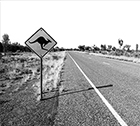
I ran into this rather cranky Central Bearded Dragon Pogona vitticeps a couple of weeks ago at the wonderful Olive Pink Botanic Garden on the fringes of Alice Springs.
It has been a long, wet and cold winter here in central Australia and the few warm sunny days we’ve been blessed with over the past weeks have prompted a lot of reptiles to emerge from their winter torpor.
That’s why this fellow was perched on a pile of rocks at the base of a rocky hill getting some rays…and looking about for any stray tucker that may wander past.
I drove over 300 kilometres around town and the backroads that day and saw quite a few Dragons and snakes out and about during the day. All to often they were on the roadway, which makes a great heatsink for animals seeking some easy warmth and also provides a good clear killing ground for animals looking to quickly recharge with some fresh tucker after a few torpid months.
I’m not all that familiar with the activity patterns of the Pogona dragons, but this brief reference from an interesting and informative article on these most attractive dragons by Raymond Hoser gives me some idea of how they regulate temperature and activity:
In the wild state, these lizards adopt the behavior of shuttling heliotherms. Their activity patterns are largely dictated by ambient temperatures and the lizards ability to operate at optimal temperatures within the environment. In cooler weather the lizards bask until optimal temperature is reached, before other activity is commenced. Basking is resumed when temperature falls below a certain level. At higher temperatures, the lizards avoid the heat of the day and alter activity periods accordingly. Therefore most active lizards are seen when temperatures fall within the preferred range, which often equates with spring and autumn.
Local birder extraordinaire Christopher Watson and I were out looking for birds but hey, when you are having a quiet bite to eat and one of these beautiful reptiles turns up within camera range how can you resist?
Steve Wilson & Gerry Swan’s marvellous “A Complete Guide to Reptiles of Australia” (New Holland Publishers, Sydney) says of the six members of the genus Pogona that:
Bearded Dragons – Six moderate to very large spp. with relatively short limbs and weakly to strongly dorsally depressed bodies…Many spines over body, limbs and tail, including a row across base of head, a row at rear edge of lower jaw, extending across throat to form a ‘beard’ in most spp. and prominent long spines along flanks. NOTES: Widespread over most of Aust., including many urban areas…Omnivorous, consuming invertebrates, small vertebrates, foliage, fruits and flowers. When harassed, flattens body, extends beard and gapes moth to reveal yellow or pink interior.

What was remarkable about the display this Central Bearded Dragon put on for us was the rapid and extreme colour change once we approached. When we first spotted him – or her – s/he was pressed flat against the rocks, a cryptic smudge of greys and blacks to match the rock it was perched on.
This camouflage serves as both a protection from predators – and there is no shortage of hungry Kites, Goshawks and Falcons around that would grab a juicy Dragon for a snack – and also as a deceptive strategy for any small creatures that the Dragon would want to eat that might wander past within range.
Not long after we got close enough to get these shots he started to turn from grey and black to the beautiful red-orange colours you see here – and to pump out his wonderful beard.
We got some quick shots and left him/her in peace. When last seen s/he was happily munching away on some leaves. We went back to our own lunch and spent the rest of the day spotting birds.
Next I’ll go looking for some of the more interesting snakes that will be roaming around central Australia over the warmer months coming up.








Crikey is committed to hosting lively discussions. Help us keep the conversation useful, interesting and welcoming. We aim to publish comments quickly in the interest of promoting robust conversation, but we’re a small team and we deploy filters to protect against legal risk. Occasionally your comment may be held up while we review, but we’re working as fast as we can to keep the conversation rolling.
The Crikey comment section is members-only content. Please subscribe to leave a comment.
The Crikey comment section is members-only content. Please login to leave a comment.